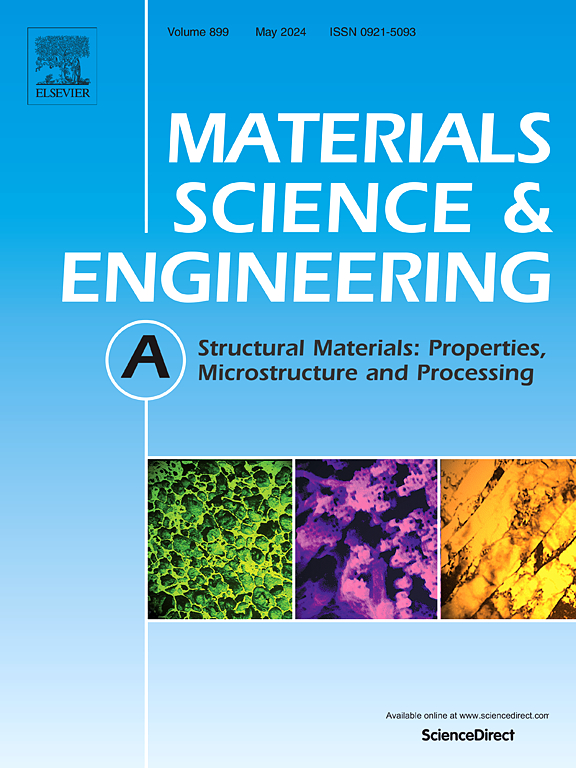Current density-dependent microstructural evolution and mechanical performance in electropulsing cyclic aging of 2195 Al-Li alloy
IF 6.1
2区 材料科学
Q1 MATERIALS SCIENCE, MULTIDISCIPLINARY
引用次数: 0
Abstract
This study systematically investigates the current density-dependent microstructural evolution and mechanical performance of 2195 Al-Li alloy during electropulsing cyclic aging (ECA). By employing gradient pulsed current densities (10–20 A/mm2), we elucidate the synergistic interplay between electron wind force and Joule heating in governing solute diffusion, dislocation dynamics, and precipitation kinetics. At a sub-threshold current density of 10 A/mm2, negligible microstructural changes yield mechanical properties identical to those of the as-received (AR) alloy. At 15 A/mm2, electron wind force-driven dislocation reorganization dominates over precipitation, inducing Portevin-Le Chatelier (PLC) effects due to enhanced solute mobility. Remarkably, at 20 A/mm2, the alloy achieves peak-aged strength (UTS: 548 MPa; YS: 516 MPa) within 5 hours–75 % faster than conventional T8 aging (155 °C/20h)-through accelerated T1 phase (Al2CuLi) nucleation and vacancy-mediated solute diffusion. Thermal-athermal synergy reduces nucleation barriers and enables dislocation density reduction, while coherent T1 phases precipitates counteract strength loss. Fractography reveals current density-dependent failure modes: ductile transgranular fracture (ECA15) transitions to brittle intergranular fracture (ECA20) due to S’ phase (Al2CuMg) formation at grain boundaries. These findings establish a paradigm for optimizing strength-ductility trade-offs via current density modulation, demonstrating 300 % aging efficiency gains, with broad implications for energy-efficient aerospace alloy processing.
2195 Al-Li合金电脉冲循环时效中电流密度相关的组织演变与力学性能
本研究系统地研究了2195铝锂合金在电脉冲循环时效过程中随电流密度变化的组织演变和力学性能。通过采用梯度脉冲电流密度(10-20 A/mm2),我们阐明了电子风力和焦耳加热在控制溶质扩散、位错动力学和沉淀动力学方面的协同相互作用。在亚阈值电流密度为10 a /mm2时,可忽略的微观结构变化产生与接收(AR)合金相同的机械性能。在15 A/mm2时,电子风力驱动的位错重组主导了沉淀,由于溶质迁移率增强,导致了Portevin-Le Chatelier (PLC)效应。值得注意的是,在20 A/mm2时,合金达到峰值时效强度(UTS: 548 MPa;YS: 516 MPa)在5小时内时效-比常规T8时效(155°C/20h)快75% -通过加速T1相(Al2CuLi)成核和空缺介导的溶质扩散。热-非热协同作用减少了成核障碍,使位错密度降低,而相干T1相沉淀抵消了强度损失。断口形貌揭示了电流密度相关的破坏模式:由于晶界处S′相(Al2CuMg)的形成,韧性穿晶断裂(ECA15)转变为脆性晶间断裂(ECA20)。这些发现建立了通过电流密度调制优化强度-延性权衡的范例,证明了300%的时效效率提高,对节能航空航天合金加工具有广泛的意义。
本文章由计算机程序翻译,如有差异,请以英文原文为准。
求助全文
约1分钟内获得全文
求助全文
来源期刊

Materials Science and Engineering: A
工程技术-材料科学:综合
CiteScore
11.50
自引率
15.60%
发文量
1811
审稿时长
31 days
期刊介绍:
Materials Science and Engineering A provides an international medium for the publication of theoretical and experimental studies related to the load-bearing capacity of materials as influenced by their basic properties, processing history, microstructure and operating environment. Appropriate submissions to Materials Science and Engineering A should include scientific and/or engineering factors which affect the microstructure - strength relationships of materials and report the changes to mechanical behavior.
 求助内容:
求助内容: 应助结果提醒方式:
应助结果提醒方式:


